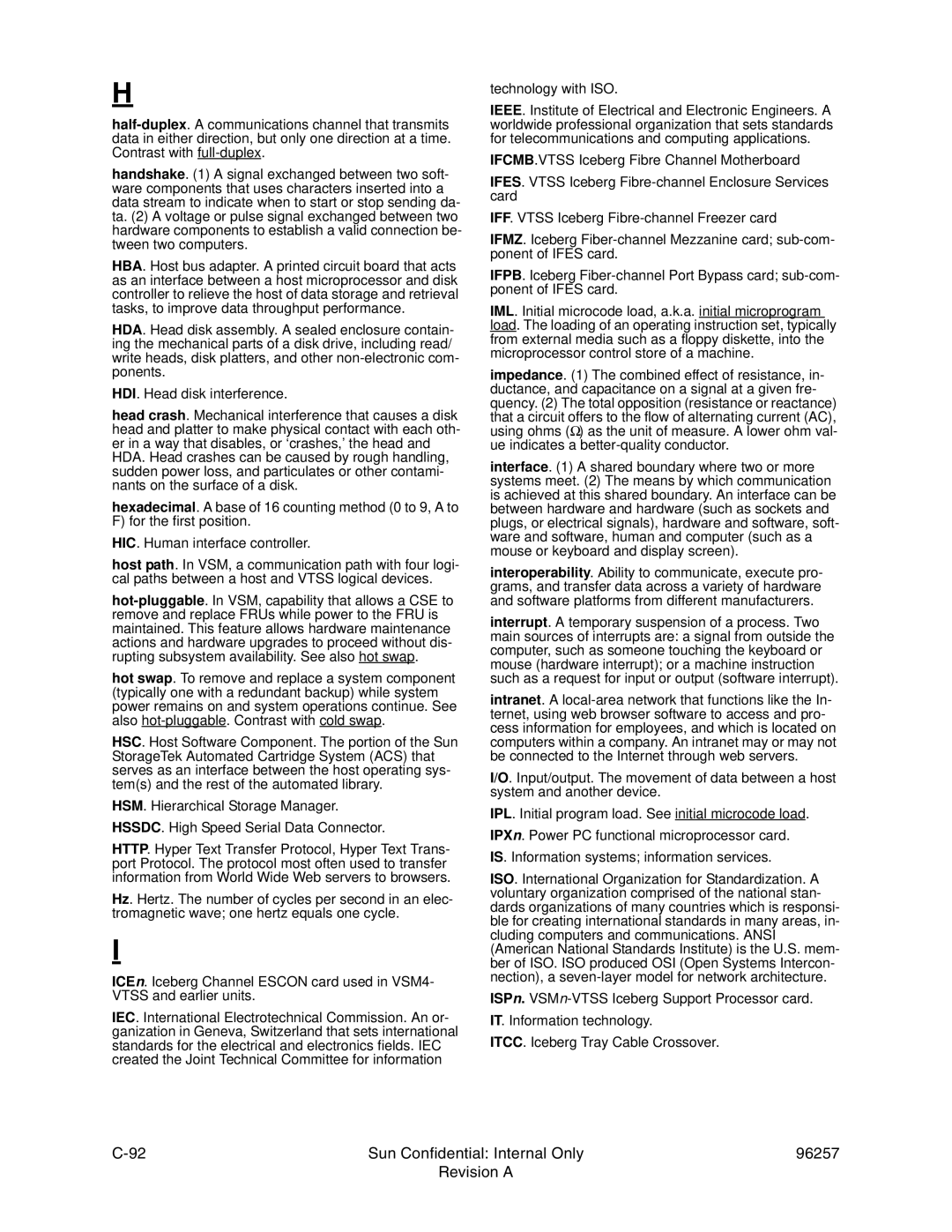H
handshake. (1) A signal exchanged between two soft- ware components that uses characters inserted into a data stream to indicate when to start or stop sending da- ta. (2) A voltage or pulse signal exchanged between two hardware components to establish a valid connection be- tween two computers.
HBA. Host bus adapter. A printed circuit board that acts as an interface between a host microprocessor and disk controller to relieve the host of data storage and retrieval tasks, to improve data throughput performance.
HDA. Head disk assembly. A sealed enclosure contain- ing the mechanical parts of a disk drive, including read/ write heads, disk platters, and other
HDI. Head disk interference.
head crash. Mechanical interference that causes a disk head and platter to make physical contact with each oth- er in a way that disables, or ‘crashes,’ the head and HDA. Head crashes can be caused by rough handling, sudden power loss, and particulates or other contami- nants on the surface of a disk.
hexadecimal. A base of 16 counting method (0 to 9, A to F) for the first position.
HIC. Human interface controller.
host path. In VSM, a communication path with four logi- cal paths between a host and VTSS logical devices.
hot swap. To remove and replace a system component (typically one with a redundant backup) while system power remains on and system operations continue. See also
HSC. Host Software Component. The portion of the Sun StorageTek Automated Cartridge System (ACS) that serves as an interface between the host operating sys- tem(s) and the rest of the automated library.
HSM. Hierarchical Storage Manager. HSSDC. High Speed Serial Data Connector.
HTTP. Hyper Text Transfer Protocol, Hyper Text Trans- port Protocol. The protocol most often used to transfer information from World Wide Web servers to browsers.
Hz. Hertz. The number of cycles per second in an elec- tromagnetic wave; one hertz equals one cycle.
I
ICEn. Iceberg Channel ESCON card used in VSM4- VTSS and earlier units.
IEC. International Electrotechnical Commission. An or- ganization in Geneva, Switzerland that sets international standards for the electrical and electronics fields. IEC created the Joint Technical Committee for information
technology with ISO.
IEEE. Institute of Electrical and Electronic Engineers. A worldwide professional organization that sets standards for telecommunications and computing applications.
IFCMB.VTSS Iceberg Fibre Channel Motherboard
IFES. VTSS Iceberg
IFF. VTSS Iceberg
IFMZ. Iceberg
IFPB. Iceberg
IML. Initial microcode load, a.k.a. initial microprogram load. The loading of an operating instruction set, typically from external media such as a floppy diskette, into the microprocessor control store of a machine.
impedance. (1) The combined effect of resistance, in- ductance, and capacitance on a signal at a given fre- quency. (2) The total opposition (resistance or reactance) that a circuit offers to the flow of alternating current (AC), using ohms (Ω) as the unit of measure. A lower ohm val- ue indicates a
interface. (1) A shared boundary where two or more systems meet. (2) The means by which communication is achieved at this shared boundary. An interface can be between hardware and hardware (such as sockets and plugs, or electrical signals), hardware and software, soft- ware and software, human and computer (such as a mouse or keyboard and display screen).
interoperability. Ability to communicate, execute pro- grams, and transfer data across a variety of hardware and software platforms from different manufacturers.
interrupt. A temporary suspension of a process. Two main sources of interrupts are: a signal from outside the computer, such as someone touching the keyboard or mouse (hardware interrupt); or a machine instruction such as a request for input or output (software interrupt).
intranet. A
I/O. Input/output. The movement of data between a host system and another device.
IPL. Initial program load. See initial microcode load. IPXn. Power PC functional microprocessor card. IS. Information systems; information services.
ISO. International Organization for Standardization. A voluntary organization comprised of the national stan- dards organizations of many countries which is responsi- ble for creating international standards in many areas, in- cluding computers and communications. ANSI (American National Standards Institute) is the U.S. mem- ber of ISO. ISO produced OSI (Open Systems Intercon- nection), a
ISPn.
ITCC. Iceberg Tray Cable Crossover.
Sun Confidential: Internal Only | 96257 | |
| Revision A |
|
